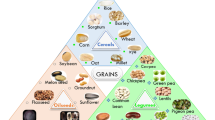Abstract
The objective of this research was to investigate the effect of chitosan on the interaction of water with bread ingredients and on the rate of staling. The changes in freezable bound water and total water contents in bread crumb were assessed by differential scanning calorimetry from water melting and evaporation endothermic peak areas. It was found that freezable water content and total water content in bread crumb decrease during staling more rapidly in the presence of chitosan. The weak interaction of freezable water with protein and starch polymeric chains in bread crumb becomes stronger, but the interaction of nonfreezable bound water with protein and starch molecules in bread crumb becomes weaker in the course of staling during bread storage. Two stages of bread crumb staling were indicated. Chitosan increases the rate of bread staling during both stages. It was suggested that during bread staling chitosan increases water migration rate from crumb to crust, prevents amylose-lipid complexation, and increases dehydration rate both for starch and gluten.






Similar content being viewed by others
References
Muzzarelli RAA (1978) Chitin. Pergamon Press, Oxford
Kumar MNVR, Muzzarelli RAA, Muzzarelli C, Sashiwa H, Domb AJ (2004) Chem Rev 104:6017–6084
Preuss HG, Kaats GR (2006) Curr Nutr Food Sci 2:297–311
Knorr D (1982) J Food Sci 47:593–595
Coma V, Deschamps A|, Martial-Gros A (2003) J Food Sci 68:2788–2782
Fernandez-Saiz P, Ocio MJ, Lagaron JM (2006) Biopolymers 6:577–583
Synowiecki J, Al-Khateeb NA (2003) Crit Rev Food Sci Nutr 43:145–171
Tsujikawa T, Kanauchi O, Andoh A, Saotome T, Sasaki M, Fujiyama Y, Bamba T (2003) Nutrition 19:137–139
Muzzarelli RAA (1997) Cell Mol Life Sci 53:131–140
Barreteau H, Delattre C, Michaud P (2006) Food Technol Biotechnol 44:323–333
Silano M, Vincentini O, Muzzarelli RAA, Muzzarelli C, De Vincenzi M (2004) Carbohydr Polym 58:215–219
Bokura H, Kobayashi S (2003) Eur J Clin Nutr 57(5):721–725
Tai TS, Sheu WH, Lee WJ, Yao HT, Chiang MT (2000) Diabetes Care 23(11):1703–1704
Pittler MH, Abbot NC, Harkness EF, Ernst E (1999) Eur J Clin Nutr 53(5):379–381
Hayashi K, Ito M (2002) Biol Pharm Bull 25(2):188–192
Metso S, Ylitalo R, Nikkila M, Wuolijoki E, Ylitalo P, Lentimaki T (2003) Eur J Clin Pharmacol 59(10):741–746
Ausar SF, Morcillo M, León AE, Ribotta PD, Masih R, Vilaro Mainero M, Amigone JL, Rubin G, Lescano C, Castagna LF, Beltramo DM, Diaz G, Bianco ID (2003) J Med Food 6(4):397–399
Gray JA, Bemiller JN (2003) Compr Rew Food Sci Food Saf 2:1–21
Schiraldi A, Fessas D (2001) Mechanism of staling: an overview. In: Chinachoti P, Vodovotz Y (eds) Bread staling, CRC Press, Boco Raton pp 1–17
Agrawal AM, Manek RV, Kolling WM, Neau SH (2003) AAPS Pharm Sci Technol 4:4
Nakamura K, Hatakeyama T, Hatakeyama H (1983) Polymer 24:871–876
McCrystal CB, Ford JL, Rajabi-Siahboomi AR (1997) Thermochim Acta 294:91–98
Sun WO (2000) Plant Physiol 124:1203–1215
Vertucci CW (1990) Biophys J 58:1463–1471
Wolfe J, Bryant G, Koster L (2002) CryoLetters 23:157–166
Bechtel WG, Meisner DF (1954) Cereal Chem 31:176–181
Lagendijk J, Pennings HJ (1970) Cereal Sci Tod 15:354–359
Schiraldi A, Piazza L, Riva M (1996) Cereal Chem 73:32–37
Ferrigno, Acampa I, Martinez-Rodriguez A, Fogliano V (2005) Del Castillo MD COST Action 927: Thermally Processed Foods; Hamburg Meeting, September 23–24, 2005, p 32
Acknowledgments
This work was carried out in the 6th Framework Programme CRAFT project “New chitosan formulations for the prevention and treatment of diseases and dysfunctions of the digestive tract (hypercholesterolemia, overweight, ulcerative colitis and celiac diseases)”. We have greatly appreciated the support of Mario Pergolini in SEM analysis.
Author information
Authors and Affiliations
Corresponding author
Rights and permissions
About this article
Cite this article
Kerch, G., Rustichelli, F., Ausili, P. et al. Effect of chitosan on physical and chemical processes during bread baking and staling. Eur Food Res Technol 226, 1459–1464 (2008). https://doi.org/10.1007/s00217-007-0677-x
Received:
Accepted:
Published:
Issue Date:
DOI: https://doi.org/10.1007/s00217-007-0677-x




